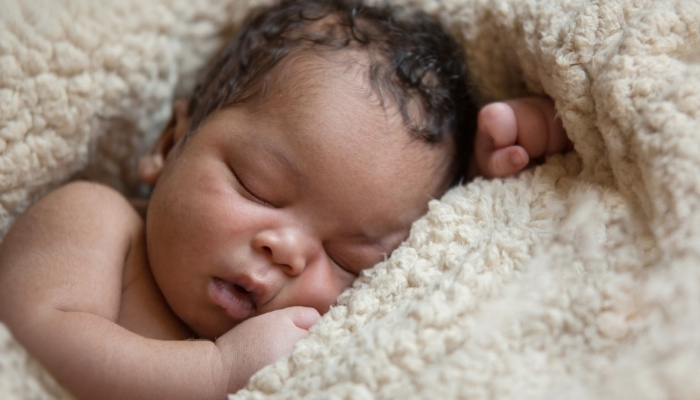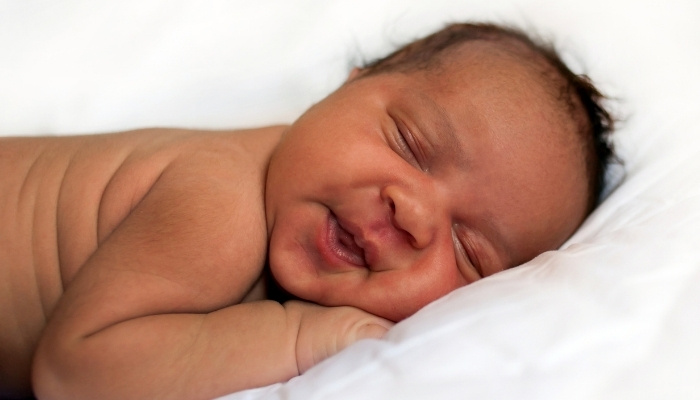It is commonly observed that black babies are different from white babies when they are born, mainly because their skin contains a higher amount of melanin. However, they may appear slightly lighter at birth compared to their later years.
By 6 six months, the true skin tone will start emerging, and by 20 months of age, the final color will be evident.
Allo Health explains:
“Each parent has two copies of a pigment gene (one from each parent), and the combination of these genes determines their offspring’s skin color …
Newborns often have a pink or reddish tint to their skin, which can gradually darken or lighten as they grow older.”
Table of Contents
Baby Skin Color – What To Expect
When a baby is born, they will bear a lighter skin tone than they will have as an adult.
A baby may have a red, purple, yellow, or blue skin tone at birth.
As blood and oxygen circulate throughout the body, a “normal” color returns, though the baby will still likely turn bright red when crying.
Babies of various ethnic and multiracial backgrounds will have darker skin tones due to increased pigmentation.
Normal Newborn Appearance
A newborn will normally have dark-red to purple-colored skin with bluish-colored hands and feet. Redness fades within the first few days.
Many newborns will still be covered in a white cheesy-looking substance called vernix, a residual coating from the infant’s time in the womb.
Every baby’s complexion will change with age. The level of skin pigmentation depends on familial factors and environmental conditions.
Black Babies’ Color When First Born
Black and biracial infants have more pigment in their skin and will be born with a darker skin tone than those of lighter-skinned descent.
It is common for infants of various ethnicities to be born paler than expected. Their skin will darken over time.
Dark-colored infants often have sensitive skin that is prone to hyperpigmentation, dryness, and dark spots.
Ensure healthy skin by using mild soap and moisturizer on your newborn.
When Mixed Babies Will Get Their Color
African-American and biracial children’s skin tones will darken within the first two to three weeks of life.
Between the ages of 6 months and 2 years, the final skin color will be evident.
Are All Babies Born White?
No, not all babies are born with white or light skin. The skin color of a newborn baby can vary widely depending on the ethnic and genetic background of the parents.
Babies can be born with a range of skin tones, from very light to quite dark.
This is because the genes responsible for skin color are inherited from both parents, and the combination of these genes can lead to a wide variety of skin colors.
Why a Baby’s Skin Color Changes
Melanin is a pigment that gives color to the skin, hair, and eyes. At birth, a baby’s melanin production may not be fully active.
Over time, as the baby grows, the melanin-producing cells (melanocytes) become more active, leading to changes in skin color.
A baby’s skin color should finally settle before the age of 2 years old. Black and multiracial babies can get much darker after birth.
The complexion and skin tone vary depending on genetics.
When Baby Skin Color Stops Changing
Baby skin color stops changing sometime around 20 months old.
Red Skin in Newborns
Due to thin, almost translucent skin and blood and oxygen going to vital organs rather than extremities, most babies are born with a reddish-purple skin tone.
The initial redness should fade within the first few days of life, but when an infant cries, their skin tone changes to bright red, and this will continue for some time.

What Determines Skin Color
Skin color is primarily determined by the amount, distribution, and type of melanin that is produced in the skin.
There are two main types of melanin: eumelanin, which is brownish-black, and pheomelanin, which is reddish-yellow.
The relative proportions and distribution of these pigments in the skin, as well as other factors, contribute to the wide range of skin colors seen in humans.
However, several genetic and environmental factors influence skin color:
- Genetics: The primary determinant of an individual’s baseline skin color is their genetic makeup. Genes inherited from parents play a significant role in determining how much melanin an individual’s skin cells produce.
- Melanin Production: Melanocytes are specialized cells found in the epidermis (outer layer of the skin) that produce melanin. The activity of these cells and the type and amount of melanin they produce vary from person to person.
- Melanin Distribution: Melanin is distributed unevenly across the skin’s surface. Factors such as genetics, hormonal influences, and exposure to UV radiation can affect how melanin is spread across the skin.
- Sun Exposure: UV radiation stimulates melanocytes to produce more melanin, resulting in a darker complexion. Over time, consistent sun exposure can lead to a permanent change in skin color.
- Geographical Ancestry: People from different geographic regions tend to have specific skin color variations. For instance, those from regions with intense sunlight often have darker skin to provide better protection against UV radiation.
- Migration and Mixing of Populations: Human migration has led to a mixing of genetic traits, including those related to skin color. This is why skin color can vary widely within populations.
- Other Genetic Influences: Certain genetic conditions and mutations can affect melanin production and distribution, leading to variations in skin color.
Which Parent Determines Skin Color?
Both parents contribute to determining a baby’s skin color. The genes responsible for skin color are inherited from both the mother and the father.
The main genes involved in determining skin color are variants of the MC1R gene.
There are multiple versions (alleles) of these genes, some of which lead to the production of more melanin (resulting in darker skin) while others lead to the production of less melanin (resulting in lighter skin).
Since each parent contributes one copy of each gene, the combination of alleles from both parents influences the baby’s skin color.
If both parents have similar variants of the MC1R gene, the child’s skin color is more likely to be similar to theirs.
However, if the parents have different variants, there’s a wider range of possibilities for the baby’s skin color.
How To Know What Skin Color Your Baby Will Have
Physical features, including skin color, come from genes donated by both parents.
It is a mixture of both parents’ genes that will determine skin color, and there is no way to accurately predict future color.
However, the color of the ears, nipples, and scrotum at birth is often indicative of final coloring.
How Newborn Ear Color Relates to Skin Color
Babies do tend to turn the color of their ears.
Though the reasons aren’t clear, many parents have found that the color of their newborns’ ears directly correlated with the mature skin color.
Newborn Nipple Color
Babies with darker skin tones will have deeper pigmentation in their nipples.
Generally, the darker the nipples are, the darker you can expect the skin color to be.
Newborn Scrotum Color
Infants who will have darker skin tones typically have deeper pigmentation on the scrotum at birth.
Dark or deep red-colored scrotums are common in infants of Asian, African, or Middle Eastern origin.
Does Skin Color Change During Puberty?
Yes, children’s skin often becomes darker as they transition through puberty as heightened hormone levels trigger over-pigmentation.
Skin darkening is especially notable in the nipples, genitals, and scrotum.
Mom of three (including identical twin boys), wife, and owner of Parents Wonder. This is my place to share my journey as a mother and the helpful insights I learn along the way.

